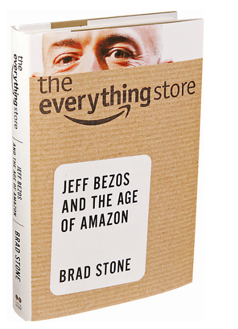Watson Says... |
 |
| The book is a general business book, but there are a few great nuggets in the book for the supply chain and operations professional. |
 |
What do you say? |
 |
| Click here to send us your comments |
|
|
|
1. Small Operational Details Can Lead to Big Strategic Advantages
In a key passage in the book, in the early 2000s, the Amazon executive team was trying to figure out if fulfillment was a core competency or should a 3rd party do it, letting Amazon focus on the technology and being a retailer. (This, by itself is interesting: the Amazon we now know was seriously considering outsourcing distribution and fulfillment.)
The reason they were asking the question is that their fulfillment system was straining to keep up with growth. And, they wanted capability they couldn’t provide—for example, telling the customer when their order would arrive.
 The executive team and outside advisors met at a fulfillment center and were studying the key bottleneck—a sorting machine. The process, like many warehouse systems, worked in waves. In a wave, the pickers would go pick product and bring it back to the sorter, and once all the pickers in that wave were done, the sorter would do its thing. There were a couple of problems with this. First, it was a batch process. So, as the book points out, if one of the hundred pickers was thirty minutes late, the whole system was late. Second, this was a critical bottleneck and they could only use it periodically (in waves). They tried to better stagger the picking and line up subsequent runs, but this only caused other worse problems. The executive team and outside advisors met at a fulfillment center and were studying the key bottleneck—a sorting machine. The process, like many warehouse systems, worked in waves. In a wave, the pickers would go pick product and bring it back to the sorter, and once all the pickers in that wave were done, the sorter would do its thing. There were a couple of problems with this. First, it was a batch process. So, as the book points out, if one of the hundred pickers was thirty minutes late, the whole system was late. Second, this was a critical bottleneck and they could only use it periodically (in waves). They tried to better stagger the picking and line up subsequent runs, but this only caused other worse problems.
After this meeting, Amazon not only stuck with in-house fulfillment, they essentially decided they needed to reinvent it and control every aspect of it.
Amazon moved to less of a batch processing system and closer to a one piece flow system popularized by Toyota and Lean Production. And, they began building their own systems, writing their own software, and removing 3rd party vendors. You can see why buying Kiva made sense in this context.
All this attention to operational detail led to big strategic advantages for Amazon- including launching Prime and 2-hour delivery. These were lessons stressed in the book Factory Physics: First, many companies have built strategic advantages by focusing on operational details—and we can now add Amazon to this list. And, second, Factory Physics has a great technical discussion on why large batch cause so many operational problems.
2. Amazon has been thinking about same Day Delivery for a Long Time.
Back around 2000, Bezos wanted to have same delivery. At that time, he suggested hiring college students on every block in Manhattan, have them stock a products in their apartment, and then make the deliveries. His team convinced him that theft was already a problem at their fulfillment centers.
The cool lesson from this story is that Amazon has been working on and thinking about big operational improvements for a long time. These things don’t just come out of nowhere, you need to be thinking about them now so you are ready when the technology and timing are right.
3. Algorithms Matter
When Amazon went about building their supply chain team, they didn’t look for experience in retail or distribution. Instead, they hired scientists and engineers.
This team went about answering typical operational questions like where to store product, where to source an order, how to route pickers in the warehouse, and even how to select the best size box.
But, this team went further and was writing the algorithms specifically for Amazon’s needs. The book claimed that these algorithms became one of Amazon’s secret weapons. They helped Amazon deliver at the lowest possible cost and make the best decisions with each of the million decisions that are made across the supply chain every hour. These small good decisions added up to a large advantage.
The lesson here reinforces what we know about the recent analytics movement—that taking advantage of your data can help implement your firm’s strategy and even open up new opportunities.
4. Goldratt’s The Goal is Still Relevant
I’ve written about the book The Goal before. I was happy to see that the book was given credit for helping the Amazon leadership team think about the constraints in their fulfillment centers.
But, even more interesting, is that the one of the things that The Goal stresses is that companies should focus more about optimizing throughput (or cycle time or sales depending on the context) and less about minimizing costs or inventory. The Everything Store paints Amazon as a company that has taken this message to heart. Amazon is a great case study about a company all about focusing on throughput and reducing the cycle time for customers.
Any reaction to this Expert Insight column? Send below.
Your Comments/Feedback
|